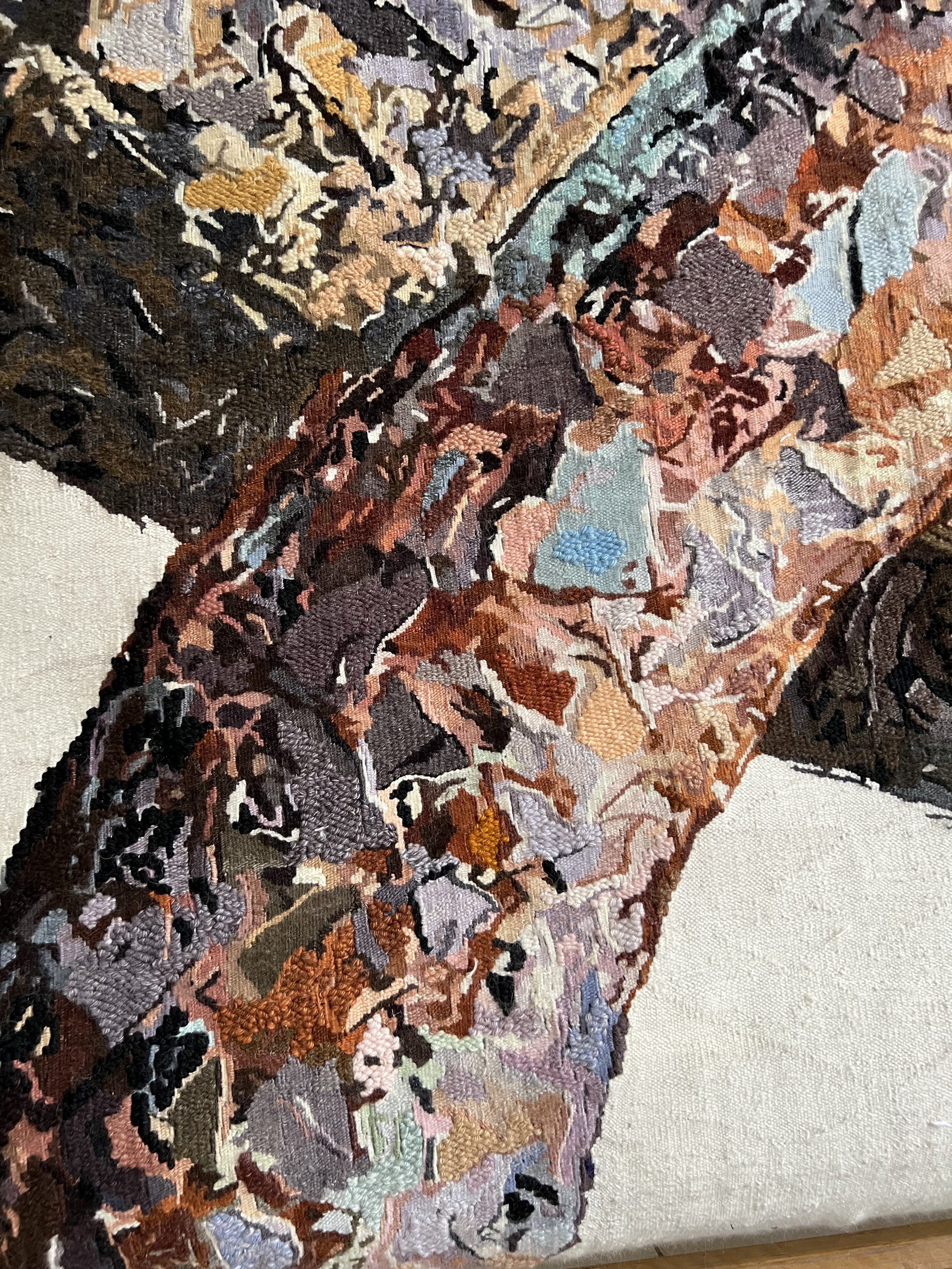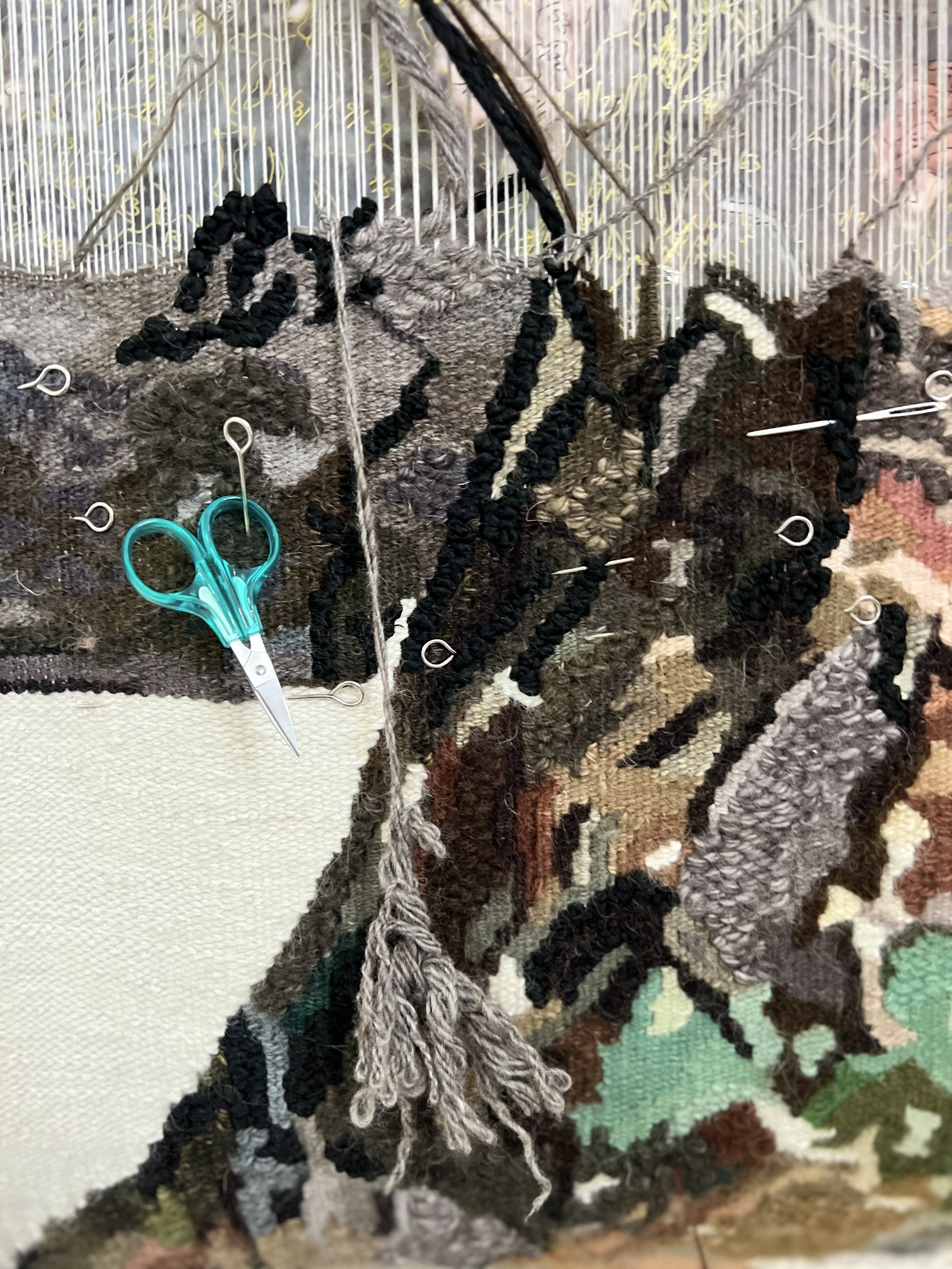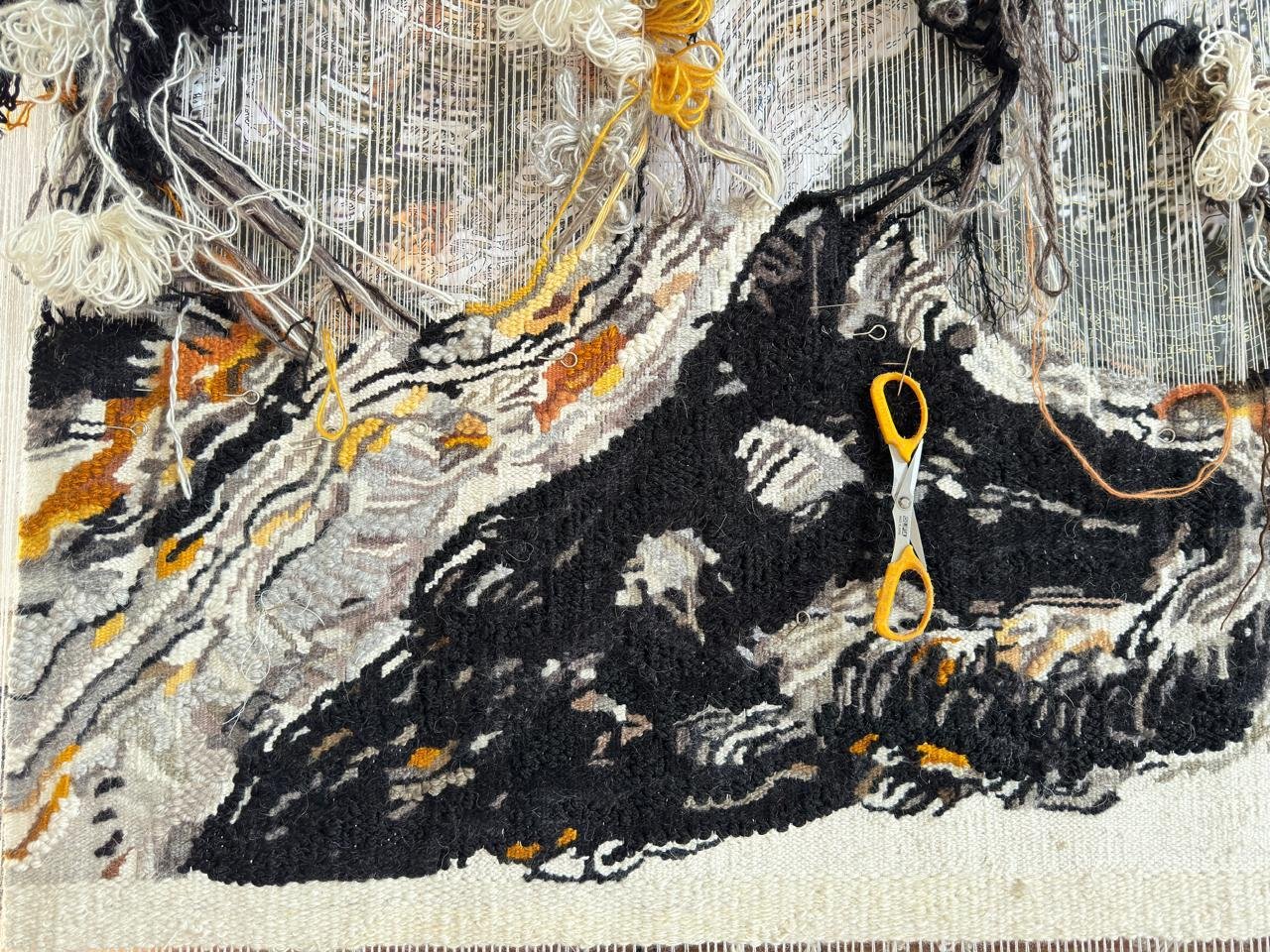GRAEME BLACK & STEPHEN’S TAPESTRY STUDIO
South Africa
Tapestry Collaboration 2025
Graeme’s tapestries have been woven by Stephens Tapestry Studio in South Africa, using raw mohair from Angora goats farmed in the Eastern Cape and neighbouring Lesotho. The Studio has worked with artists for more than half a century and their pieces hang in museums and private art collections all over the world.
Duiker #32 Diptych
Weavers: Buhle Mamba, Rhoda Sori, Mumcy Mudau, Tracy Thiba, Treasure Zulu
Cartoon development & direction: Tina Weavind
Each 224cm x 154cm
Graeme created the original ink drawing for Duiker #32 Diptych in Kommetjie, a village on the rugged coastline of the Cape Peninsula in 2024. It was inspired by a charred eucalyptus tree that he discovered behind the property in which he was staying, a victim of the bush fires that are common in the region.
Though the trees seem to survive, the flames lick around the trunks, creating incredible colours on the surface of the bark, which grows spirally around the structure of the tree. “I was amazed at the incredible colours left on the surface,” says Graeme, “and sought to capture this particular beauty in my ink studies.” Presented in four vertical panels, Duiker Diptych is part of a series that was exhibited in 2024 at Connolly art gallery in Mayfair, London.
The weavers’ biggest challenge was to ensure that the two tapestries could be installed both individually or as a single work. The top of the first tapestry therefore needed to match the bottom edge of the second. “Because both tapestries were woven sideways, this meant measuring each shape on the right side of the first tapestry and making sure it matched as closely as possible to the left side of the second tapestry on the loom,” says Tina.
Longwood #22, Detail
Detail mohair/wool mix
Edition 1 of 3
Weavers: Treasure Zulu, Tracy Thiba, Mumcy Mudau
Cartoon development & direction: Tina Weavind
2.20m x 1.45m
Longwood Study was inspired by trees in the forest surrounding Graeme’s farmhouse in Yorkshire, through which he walks daily, observing the effects of light, weather and the changing seasons.
As with all of his paintings, Longwood is a composite rather than a portrait of a particular species or individual tree, designed rather to recreate the feeling of being in nature. “When I close my eyes, what do I remember of the tree I just saw?” he explains. “Which are the textures and colours that stand out? In this way, I’m able to achieve a more interesting interpretation.”
The quadripitch Longwood 22/23/24/25 was originally shown at Marders Gallery, Bridgehampton, USA in 2022.
After isolating the form of a branch or trunk, each piece began with a pencil and charcoal study, to which Graeme added washes of diluted oil paint with a brush, switching to a palette knife for his final layer of colour.
Longwood was the first of Graeme’s works to be turned into a tapestry and “a big learning curve for us all,” says Tina. “I struggled to develop a cartoon that would translate into a tapestry with sufficient texture and shading.” To better reenact the light-play integral to the original painting, she Woodend #22/23/24/25. 2022 chose to intensify certain brights and darks. Still, “the first two iterations felt flat and lifeless. I must have started and rejected it about six times, and my weavers wanted to resign. But it turned out amazing. My weavers are extraordinary.”
Bosco Blue II, Detail
Detail mohair/wool mix
Edition 1 of 3
Weavers: Treasure Zulu, Tibenele Vilikati, Tracy Thiba
Cartoon development: Tina Weavind
2.55m x 1.30m
In his work, Graeme will often enlarge or reduce areas of a painting in order to discover new compositions. This tapestry is a detail of the quadtych painting Bosco II. “I thought an intense close up would add drama to the tapestry,” he explains.
To create a tapestry of these proportions, the original ink drawing was blown up to five times its original size, imbuing the tapestry design with a new bold, graphic quality. Graeme also added shades of moonlight blue “to give a nocturnal poetry.”
The introduction of softer hues of taupe and grey lent a sense of warmth to the trunk structures. In discussing this piece with Tina, we decided to increase the number of colours to create a more sophisticated interpretation of the original black ink painting. Each trunk had its own unique colour personality which gave richness to the final composition. It was a wonderful collaboration.
Tina created the form and textural weight of the trunks with soft beige, granite and ivory. “It was an honour to be asked to transform the colour palette of the original painting” she says. “I felt Graeme really trusted my judgement. He never tried to micromanage the production of his tapestries and this is a clear example.”
Abstract but half recognisable, the tapestry relays the essence of a forest at night: the gathering dusk, the sensory disorientation we experience in the woods and a cool, otherworldly beauty teeming with unseen numinous forces.
Bosco II
Yorkshire mohair/wool mix
Edition 1 of 3
Weavers: Treasure Zulu, Tracy Thiba, Tibenele Vilikati, Rhoda Sori
Cartoon development & direction: Tina Weavind
3.15m x 2m
The Bosco tapestries are based on black-and-white studies of the leafless sections of trunk and branch that are visible between the sash bars of the 18th-century windows inside Graeme’s home during winter.
“You’re never seeing the tree completely,’ he explains. ‘It’s split up, dissected. It began as an exercise: four bits of paper to represent the panes, tracing the stark shapes of the branches and the way they moved around the composition – and just black oil paint on raw canvas or ink on paper.”
Working in black and white was a transformative experience: “When you take away colour, you have to create form in a different way,” Graeme says. “Black and white intensifies form, and the way light and dark play out across the trunks. You see much more clearly how they differentiate from one or other. That no tree trunk is the same.”
This quadtych began as a study in ink of four intersecting trees. Graeme used various sizes of paint brush to render texture and light, particularly sunlight bleaching out the bark’s detail in certain areas. It was first shown as part of an online exhibition at Thorns Gallery, Raydale, in 2023.
Developing the cartoon took several months. While there were considerably fewer colours than in Longwood, the detail needed to be specific and weaving absolutely accurate, though “by then, we had a better idea of how to get the effect I wanted,” says Tina. Her interpretation imbued the final piece with an air of solidity, suggestive of established trees, saturated with the centuries.
Bosco III
Mohair/wool
Edition 1 of 3
Weavers: Mumcy Mudau, Treasure Zulu, Tracy Thiba, Tibenele Vilikati
Cartoon development: Tina Weavind
2.75m x 1.75m
Bosco III began life as six sepia ink drawings on thick watercolour paper. Graeme conceived of the polyptych as a single piece – the trees’ knotted, gnarly, crisscrossing boughs evoked in fine strokes and soft stains.
This piece will form part of the inaugural exhibition “From Nature” group show at Thorns Gallery opening July 2025. While other paintings in the Bosco series were made with black Indian ink, here sepia created an intentionally softer, airy feel. Buttermilk, tangerine and lemon hues enhance that mood, lending the drawings a delicate, poetic balance.
“This tapestry is like a watercolour, soft and beautiful,” says Tina. “Each branch has a slightly different texture – the shades on the very left were softer than all of the others, for example.” Her interpretation introduced additional grey tones, giving the finished tapestry a unique feel.
Part of the concept for the piece was to emulate the ‘deckle’ edges of the original watercolour paper. Mimicking the effect of multiple sheets joined together created tiny openings that had to be stitched post weave.
A symphony of aqueous earth tones, the finished piece is ethereal in feel, evoking the kind of forest that lies beyond the ordered world.















